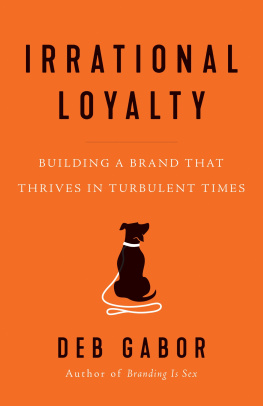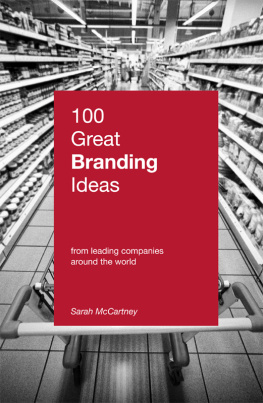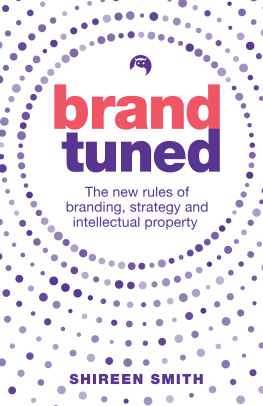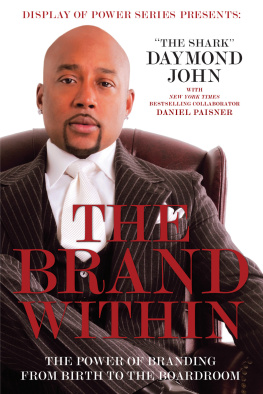All rights reserved.
I dedicate this book to the people behind the best brands in the world: the thoughtful stewards of brand promises, relationships, and experiences that attractand hold dearly in their heartslegions of irrationally loyal fans.
Introduction
Can you imagine a brand that literally kills three of its customers (as in dead ), yet somehow the (surviving) customers remain loyal and devoted to the company and its products?
This is not a rhetorical question. It really happened. Its an incredible story of a brand that suffered a massive branding disaster but handled it the right way and came out stronger on the other side.
If youre from the Lone Star State, you have heard of Blue Bell ice cream. Blue Bell Creameries has been satisfying Texans sweet tooths for more than a century. Founded in 1907, the company expanded into dozens of midwestern and southern states, bringing their addictive flavorssuch as Moo - llennium Crunch, Cookie Two - Step , and my favorite, Peppermint Barkto millions of loyal customers. The company earned a reputation for producing a great product at a fair price and treating its employees like family.
In 2015, disaster struck. Five Blue Bell customers came down with cases of the infectious foodborne disease, listeria, linked directly to contaminated Blue Bell ice cream. Three people died.
The company responded immediately by issuing the first product recall in its 108- year history. They removed eight million gallons of ice cream from store shelves and disposed of it in a sanitary landfill. Then management closed most of the companys manufacturing operations and distribution centers for decontamination and cleaning.
The situation lasted for months and threatened to bankrupt Blue Bell. Nevertheless, true to its brand promise and reputation, Blue Bell continued to pay its employees. The company had to secure a $125 million loan to pay for salaries during the shutdown and for the continued cleanup operation. Since Blue Bell was a major employer in its hometown of Brenham, customers throughout Texas who loved the brand followed the evolving saga as it played out on the local news.
While Blue Bell fought its way back from being deeply in debt and on the brink of bankruptcy, people noticed that the company put its employees and its customers safety ahead of profitsahead of even the survival of the company. In September 2015, when Blue Bells Homemade Vanilla reappeared on store shelves, customers lined up to buy itliterally out the door, around the corner, and down the streetat grocery stores across Texas. It was like they were waiting in line for hot concert tickets.
For many months, as manufacturing slowly ramped up again, the only flavor available was vanilla. Not everyone likes vanilla. But loyal customers lined up to buy it anyway, just to support Blue Bell, whether they intended to eat it or not.
That is an example of irrational loyalty.
Irrational Loyalty
Irrational loyalty exists when customers are so dedicated to a certain brand that their lives would be diminished if that product disappeared. Irrational loyalty means customers wouldnt even consider using an alternative brand; theyd feel like they were cheating . The way brands build irrational loyalty among their customers is by bonding emotionally.
Emotional Bonds
Blue Bell had forged deep emotional relationships with its customers and employees by building up positive brand equity and goodwill. Thats how they were able to endure and overcome such a horrifying tragedy. There are things you can do in the creation, management, and leadership of your own brand to ensure that you build a solid emotional bond with your customers.
Similarly, as with relationships between people, you form the strongest bonds when theres alignment of values and beliefs. At the foundation of the relationship there is inherent trust and accountability, which create an emotional bond. If there is a strong enough emotional bond, the relationship can survive when someone screws up.
Blue Bell Creameries literally killed some of its customers . But because of the companys commitment to its brand promise, it acted in a way consistent with the Blue Bell brand. When disaster struck, Blue Bell lived up to its values. As a result, the loyalty that customers felt to the brand strengthened and grew into irrational loyalty, solidifying the companys standing in the marketplace and ensuring the brands continued survival for decades to come.
Can your brand survive a disaster like that?
Brands Screw Up All the Time
In todays world, there are more opportunities for brands to screw up publicly than ever before. News and information travel at the speed of broadband. Anything and everything you do as a brand can be captured on smartphone video, streamed across the globe in a matter of minutes, and memorialized for eternity on Facebook and Twitter. And you have no control over it. Just ask United Airlines. (Well talk about them as a cautionary tale later in the book.)
Every company and every brand eventually will get into hot water. It is unavoidable. It may not even be your fault. Many brand crises are external; they come from unforeseen outside forces. For example, the National Football League had no idea Colin Kaepernick would cause a national controversy when he decided to kneel during the National Anthem. The NFL never saw it coming. But the branding crisis it caused landed squarely in the NFLs lap. They had to deal with it.
The question is not whether your brand will eventually face controversy or calamity. The question is how to react when it happens. The key is to always respond in accordance with your brand promise.
When Hurricane Harvey flooded large parts of Texas, Bass Pro Shops reacted with their brand promise in mind. They provided more than eighty bass boats to help in the search, recovery, and relief efforts. They also donated survival supplies and snacks like beef jerky and bottled water for first responders and rescue crews.
As we will discuss in the coming chapters, a crisis can be the best time to reinforce your brand promise and your commitment to your customers. Unfortunately, its also a time when many brands drop the ball and suffer because of a botched strategy.
Branding Is Sex Gets into a Committed Relationship
All brands want to enjoy the condition of irrational loyalty from their customers, just like Blue Bell. In my previous book, Branding Is Sex: Get Your Customers Laid and Sell the Hell Out of Anything , I gave concrete, nuts - and - bolts , how - to advice to help brands build that kind of loyalty. This book picks up where that book left off.
BIS used the analogy of the early stages of a romantic relationship to illustrate the basics of branding. It included attracting and courting customers, sealing the deal, and building the emotional bonds that lead to loyalty. This second book continues that relationship theme by taking romance to the logical next stepactually being in a committed relationship with your customer for the long term.
Now the honeymoon is over and the initial shine of courtship has dulled, replaced with the day - to - day realities of life together and all its ups and downs. One of the partners in the relationship has traded in the rose - colored glasses for a worn - out pair of sweatpants and bunny slippers, and started peeing with the bathroom door wide open. The other partner comes to bed covered in face cream and wearing their fluffiest, most comfortable pajamas. Theres comfort, contentment, and trust. But the spark of intrigue and excitement has dimmed a bit. The fog of pheromones has cleared, and you begin to see your partner for who they really are.









